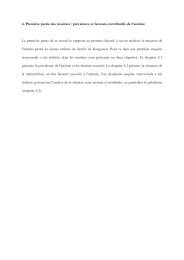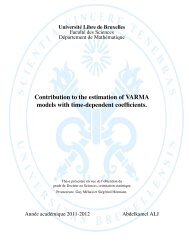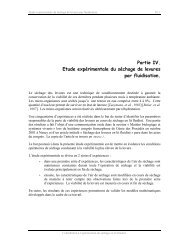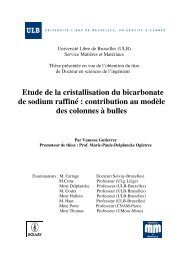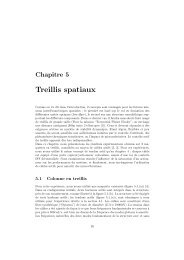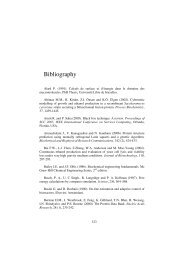Diapositive 1 - de l'Université libre de Bruxelles
Diapositive 1 - de l'Université libre de Bruxelles
Diapositive 1 - de l'Université libre de Bruxelles
You also want an ePaper? Increase the reach of your titles
YUMPU automatically turns print PDFs into web optimized ePapers that Google loves.
Chapitre ITable 5: Skeletal Mg/Ca and Sr/Ca ratios in the massive skeleton of Petrobiona massilianaaccording to sampling sites (mean ± standard <strong>de</strong>viation, n=5).Location Latitu<strong>de</strong>-Longitu<strong>de</strong> Mg/Ca(mmol/mol)mean ± S.D.Sr/Ca(mmol/mol)mean ± S.D.MeanannualSST (°C)La Vesse(France)Capo Caccia(Sardinia, Italy)Kalithea Bay(Rho<strong>de</strong>s, Greece)43°20'28''N - 05°15'41''E 114.77 ± 9.07 2.27 ± 1.47×10 -2 17.6540°33'40''N - 08°09'41''E 125.98 ± 3.47 2.51 ± 2.93×10 -2 18.7336°22'49''N - 28°14'22''E 137.62 ± 2.37 2.53 ± 1.96×10 -2 21.75DISCUSSIONUp to now, growth rate of massive basal skeletons of Calcispongiae was unknown. In thepresent study, in situ calcein labelling experiments showed that the average skeletalgrowth rate of the calcisponge Petrobiona massiliana was 236 µm/yr. This value is closeto average growth rates (ranging from 100 to 300 µm/year) reported for massive basalskeletons of tropical species of Demospongiae (Ceratoporella nicholsoni,Astrosclera willeyana, Acanthochaetetes wellsi), <strong>de</strong>spite the differences between tropicaland Mediterranean field conditions (Willenz & Hartman 1985, 1999, Reitner & Gautret1996, Wörhei<strong>de</strong> 1998). A maximum height of 20 mm has been reported for hemisphericalshaped P. massiliana living in caves protected from hydrodynamism (Vacelet 1964). Inregards of growth rates measured in this study, and consi<strong>de</strong>ring that growth is constant intime, lifespan of this species can be estimated to be approximately 85 years, a relativelyshort lifetime in comparison with other hypercalcified sponges, which can live severalcenturies (Swart et al 1998).Our SEM and epifluorescence microscopy observations highlighted some processesinvolved in the skeletal growth of P. massiliana. As previously <strong>de</strong>scribed by Vacelet(1991), some calcareous spicules were entrapped within the calcitic mass during growth.These entrapped spicules (or their imprint) were also observed across the entire thicknessof fractured skeletons, confirming that spicules do not dissolve in the mass of the skeleton(Vacelet 1991). Intense calcein fluorescence was observed on the conical protuberances atthe skeleton surface, indicating that they were actively growing at the time of incubation.The discontinuous calcein lines suggest that growth was spatially discontinuous.However, growth rates were similar at the apex of skeletal crests and in skeletal43



